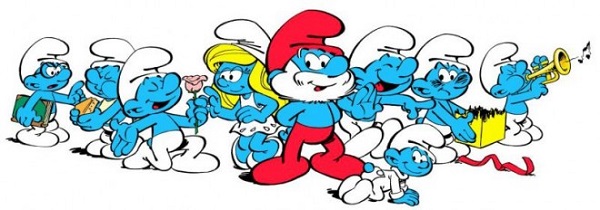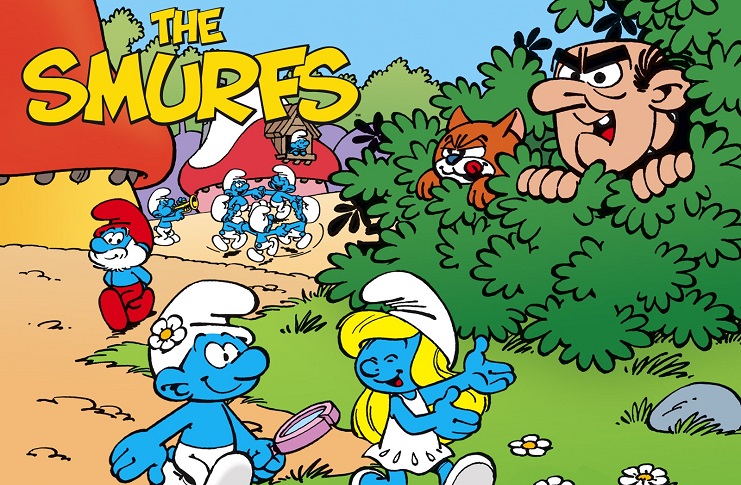
Everybody sing along! La la la la la la, la la la la la!
I mentioned in previous columns that Saturday morning cartoons in the 1980s were different from syndicated cartoons of that period, the latter of which were largely meant to sell toys and were financed by toy companies. As a result, they didn’t have any problem targeting a specific gender or age group. But Saturday morning shows mainly were financed by ad sales, so they were designed to appeal to the largest audience possible — boys and girls of all ages. As a result, a lot of ’80s cartoons were neutral in their appeal, and one of the hugest such hits of the era was The Smurfs.
The Birth of The Smurfs
The Smurfs was based on the Belgian comic strip Les Schtroumpfs (its French title) or De Smurfen (Dutch). (They speak both languages in Belgium.) The characters were created by the cartoonist Peyo (real name: Pierre Culliford) and premiered in his comic strip Johan et Pirlouit (Johan and Peewit in English) in 1958. “Schtroumpfs” was a word Peyo made up while in the company of fellow cartoonist André Franquin. Franquin couldn’t remember the word “salt,” so the pair continued to say “Schtroumpfs,” substituting it for various nouns and verbs.
English-speaking fans will surely remember the way the Smurfs did the same with the word “Smurf.” “Let’s Smurf down to the Smurf.”
Les Schtroumpfs proved so popular that they were given their own comic strip in 1959. The strips spawned the first wave of Smurfs merchandising.
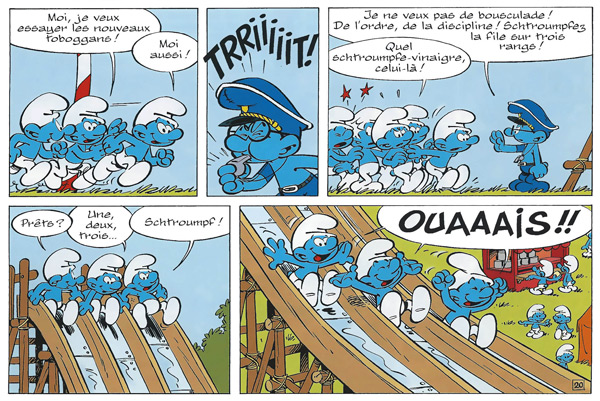
Les Schtroumpfs/De Smurfen was massive in Europe for decades. In 1976, the animated film La Flûte à six schtroumpf (The Smurfs and the Magic Flute) was released. It was produced by Éditions Dupuis and Belvision Studios, and it adapted the first storyline from the Johan et Pirlouit strip.
The popularity of Les Schtroumpfs/De Smurfen spread across Europe and beyond, eventually attracting a fanbase in the United States, largely based on the collectible PVC figurines and other merchandising.
The Smurfs Land On American TV
In the late ’70s-early ’80s, NBC President Fred Silverman came up with the idea to produce a cartoon based on the property when his daughter Melissa bought a Smurf doll.

The show was animated by Hanna-Barbera and debuted on NBC Saturday mornings in 1981. It became the top-rated cartoon on TV. Initially, there were 99 Smurfs who lived in Smurf Village inside mushroom houses. In most materials, the Smurfs are said to be “three apples” tall, but they seem much smaller than that — closer to maybe three inches. They have blue skin and most wear white pants and a white hat that resembles a Phrygian cap. Their leader, Papa Smurf, wears red pants and a hat.
A few of the Smurfs sport unique garments. Handy wears overalls. Baker wears a chef’s hat. Painter wears a black beret and a red smock. etc.
Smurf Village is nestled in a forest and generally can’t be found by humans unless they are led there by a Smurf. The Smurfs’ primary diet consists of red Smurfberries, which resemble cranberries.
The Smurfs are named based on their personalities (Lazy, Hefty, Jokey) or professions (Painter, Poet, Farmer).
They are pursued by the evil wizard Gargamel and his cat Azrael. Gargamel’s motivation alternates between him wanting to eat them (EW!) or using them to create gold. At other times, he seems driven by revenge after the Smurfs foil his plans so many times.

It Takes A Village
At the beginning of the series, Gargamel creates the first female Smurf, Smurfette, to infiltrate the village, but Papa was able to sway her to their side and made her a full Smurf. Originally, she had short black hair, but upon turning into a real Smurf, it turned long and blonde. Her personality was somewhat stereotypical. She tended to get scared and panic at signs of danger, requiring her to be rescued by a male Smurf, but she also had a “know-it-all” streak. Upon the introduction of Baby Smurf in Season 3, she became maternal and was his primary caregiver.
In 1985, four Smurflings (children) were introduced. Actually, these were adult Smurfs that were de-aged — Nat (Natural) Smurfling, Snappy Smurfling, and Slouchy Smurfling. Of the Smurflings, (I think) only Natural Smurf had appeared previously in adult form. They created a female, Sassette, using Gargamel’s original spell that he used to create Smurfette. As a result, she was also evil at first, but became good and acted as a younger sister to Smurfette. But due to being created by one of Gargamel’s spells, she has a soft spot for him and calls him “Pappy Gargamel.”
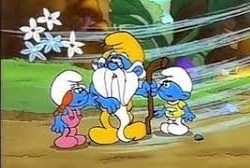
Season 6 introduced Grandpa Smurf, the father of Papa, who returned to Smurf Village after a 500-year journey around the world. Season 8 saw the debut of Nanny Smurf, an elderly female who had been imprisoned for 500 years before Grandpa and others rescued her. She appears to be his “sweetheart” but is clearly not his wife or the mother of Papa. (I really don’t want to speculate on The Smurfs’ reproductive process, so let’s just move on.)
The majority of the male Smurfs played roles of varying degrees of importance, so I won’t delve into them.
Among the voice cast were:
Charlie Adler as Natural “Nat” Smurfling
Jack Angel as Enchanter Homnibus
Michael Bell as Grouchy Smurf, Handy Smurf, Lazy Smurf, Johan, Gargamel (S9… maybe)
Lucille Bliss as Smurfette
Susan Blu as Nanny Smurf
William Callaway as Clumsy Smurf, Painter Smurf
Joey Camen as Natural Smurf
Hamilton Camp as Greedy Smurf, Harmony Smurf, Woody, Gargamel (S9… maybe)
Jennifer Darling as Princess Sabina
Marshall Efron as Sloppy Smurf
Bernard Erhard as Timber Smurf
June Foray as Jokey Smurf, Mother Nature, Gargamel’s mother
Pat Fraley as Tuffy Smurf
Danny Goldman as Brainy Smurf
Kip King as Tailor Smurf
Kenneth Mars as Harmony Smurf
Julie McWhirter as Baby Smurf, Sassette Smurfling
Don Messick as Papa Smurf, Azrael, Dreamy Smurf, Sickly Smurf, Sweepy Smurf
Pat Musick as Snappy Smurfling
Noelle North as Slouchy Smurfling
Alan Oppenheimer as Vanity Smurf, Father Time
Rob Paulsen as Marco Smurf
Henry Polic II as Tracker Smurf
Philip Proctor as King Gerard
Dan Radloff as Sneaky Smurf, Spy Smurf, Stinky Smurf
Ronnie Schell as Pushover Smurf, Jokey Smurf (early Season 1 episodes)
Frank Welker as Hefty Smurf, Clockwork Smurf, Peewit, Poet Smurf, Wild Smurf
Paul Winchell as Gargamel (1981–1988), Nosey Smurf
Jonathan Winters as Grandpa Smurf
Alan Young as Miner Smurf, Farmer Smurf, Scaredy Smurf
The Human Element
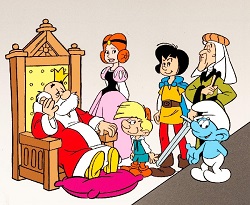
Beginning in Season 2, the Smurfs shared many adventures with the humans Johan, a brave young page boy, and his short companion Peewit (pronounced “Pee Wee”), who plays the lute and sings off-key. He is always hungry. Johan rides a white horse named Bayard, while Peewit rides a goat named Biquette.
As mentioned, Les Schtroumpfs/De Smurfen originated in the Johan et Pirlouit comic strip. In France, The Smurfs episodes featuring Johan and Peewit actually aired under the name Johan et Pirlouit.
Apparently, in the original comics, Peewit/Pirlouit was an adult little person, but he is portrayed as a child in the American cartoon.
Johan and Peewit serve under a kindly King who is never given a name. Despite his age, he yearns to go on adventures. His niece, Princess Sabina has a crush on Johan (the feeling is mutual), but their relationship stays innocent and chaste. Sabina is watched over by the stern Dame Barbara.
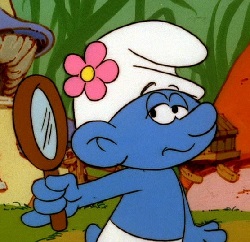
Johan, Peewit, the King, and Princess Sabina all befriend the Smurfs, but Dame Barbara is never made aware of their existence.
Another recurring human character was Enchanter Homnibus, a wizard/alchemist who is friends with Papa Smurf and frequently visits Smurf Village. Though it doesn’t appear to be canon, in 1980, the song “Smurfing Land” on the album Smurfs Sing Song, stated that Homnibus created the Smurfs and their Village.
At the height of The Smurf’s success in 1983, the 1976 movie was re-released in the U.S. as The Smurfs and the Magic Flute. Since it was not created by Hanna-Barbera, there are numerous differences between it and the show that was airing at the time.
End of an Era
The Smurfs was a true smash! It won a Daytime Emmy award. It ran for a whopping nine seasons. In total, there were 258 episodes, consisting of 425 shorts. It went on to be syndicated and later, aired on Cartoon Network and Boomerang. In addition, seven primetime specials aired on NBC, although the first was just three regular episodes put together and it aired before the regular series’ launch. It seems NBC knew it had a hit on its hands.
By the end of the ’80s, The Smurfs’ popularity was waning and NBC canceled it along with all of its Saturday morning cartoons to make way for live-action programming, following the success of Saved by the Bell.
Oddly, The Smurfs has not been released on home video in its entirety. Season 1 was released in two boxed sets, but only a few scattered episodes of Season 2 have been released on single-disc releases, along with some of the specials. That’s it.
Beyond the Small Screen
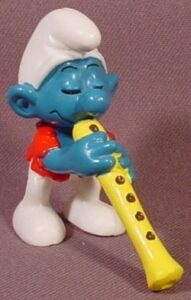
There is way too much Smurfs merchandising to even discuss. They slapped these little blue critters in everything they could think of, but the small PVC figurines are probably the most popular and famous They still make them. They were and continue to be produced by the German company Schleich.
The Smurfs were featured for years as part of the Ice Capades and were also showcased at various theme parks around the world, including the Six Flags chain in the U.S. (They still serve the blue Smurfs ice cream at King’s Island, here in Cincinnati, but it doesn’t have the branding. It’s just called “blue ice cream,” I think.)
The popularity of The Smurfs may have faded in the ’90s, but nostalgia endured and in the 2010s, Sony revived them for a series of live-action (ish) theatrical films. The first came out in 2011 and was a massive hit. Hank Azaria played Gargamel and looked exactly like the cartoon character. The Smurfs 2 was released in 2013 but was not as successful. The third movie, The Smurfs: The Lost Village was completely animated and came out in 2017, but by this point, the franchise had again run out of steam.
But not for long. A new animated series debuted on Nickelodeon in 2021 and given a second season renewal.
The Smurfs was, without a doubt, one of the most successful Saturday cartoons of all time and remains a perennial favorite for multiple generations. Was it one of yours?
